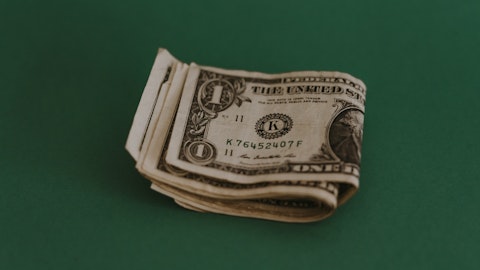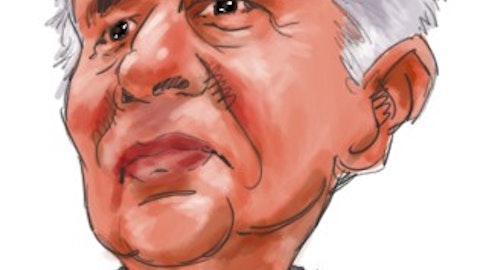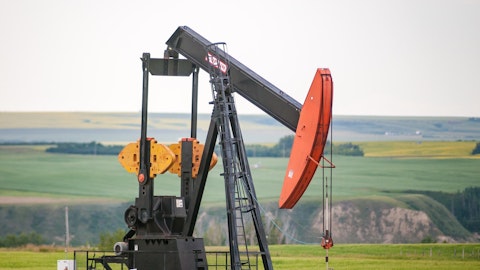CVR Energy, Inc. (NYSE:CVI) Q1 2023 Earnings Call Transcript May 2, 2023
CVR Energy, Inc. beats earnings expectations. Reported EPS is $1.44, expectations were $1.04.
Operator: Greetings, and welcome to the CVR Energy, Inc. First Quarter 2023 Conference Call. As a reminder, this conference is being recorded. It is now my pleasure to introduce your host, Richard Roberts, Vice President of Financial Planning and Analysis and Investor Relations. Thank you, sir. You may begin.
Richard Roberts: Thank you, Christine. Good afternoon, everyone. We very much appreciate you joining us this afternoon for our CVR Energy first quarter 2023 earnings call. With me today are Dave Lamp, our Chief Executive Officer; Dane Neumann, our Chief Financial Officer; and other members of management. Prior to discussing our 2023 first quarter results, let me remind you that this conference call may contain forward-looking statements as that term is defined under federal securities laws. For this purpose, any statements made during this call that are not statements of historical facts may be deemed to be forward-looking statements. You are cautioned that these statements may be affected by important factors set forth in our filings with the Securities and Exchange Commission and in our latest earnings release.
As a result, actual operations or results may differ materially from the results discussed in the forward-looking statements. We undertake no obligation to publicly update any forward-looking statements, whether as a result of new information, future events or otherwise, except to the extent required by law. This call also includes various non-GAAP financial measures. The disclosures related to such non-GAAP measures, including reconciliation to the most directly comparable GAAP financial measures, are included in our 2023 first quarter earnings release that we filed with the SEC and Form 10-Q for the period and will be discussed during the call. That said, I’ll turn the call over to Dave.
Dave Lamp: Thank you, Richard. Good afternoon, everyone, and thank you for joining our earnings call. Yesterday, we reported first quarter consolidated net income of $259 million and earnings per share of $1.94. EBITDA for the quarter $401 million. Our strong quarter results for the quarter were driven by high gas and diesel cracks in the Refining segment, and record high production volumes in the Fertilizer segment. We are pleased to announce that the Board of Directors has authorized the first quarter dividend of $0.50 per share, which will be paid on May 22nd to shareholders of record on the close of the market on May 15th. Our annualized dividend yield of approximately 7%, based on yesterday’s closing price remains best in class among independent refiners.
In our Petroleum segment, combined total throughput for the first quarter of 2023 was approximately 196,000 barrels per day, and light product yield was 100% on crude oil processed. We began the planned coker turnaround at Coffeyville at the end of February, and work was completed in early April. Benchmark cracks remained elevated during the first quarter, with Group 3 2-1-1 averaging $34.16 per barrel. The distillate crack remained above gas crack in the first quarter, although gas cracks have improved significantly recently. While the incentive in the group is still to operate refineries in max distillate mode, we have the ability to swing production from distillate to gasoline by approximately 5% to 10%, if economics dictate. RIN prices declined slightly in the fourth quarter — from the fourth quarter, but remained stubbornly high at $8 per barrel.
On our last earnings call, I highlighted that we filed petitions with the Fifth Circuit seeking judicial review of EPA’s ridiculous and misguided denial of Wynnewood’s small refinery exemptions for 2017 through 2021. I am pleased to announce that the Fifth Circuit recently ruled to stay Wynnewood’s compliance obligation after noting EPA’s June 2022 small refinery exemption denial was likely contrary to the law. Small refineries across the country have filed similar lawsuits with compliance days being granted so far for certain small refineries in the Fifth, Eleventh and DC circuits. As we have stated many times in the past, the RFS regulation was written to protect small refineries like Wynnewood from disproportionate economic harm caused by absurdly high RIN prices, and we will continue to fight for our rights that we believe Wynnewood is entitled to.

Photo by Ronan Furuta on Unsplash
We continued to increase throughput rates at our Wynnewood renewable diesel unit in the quarter, processing approximately 22 million gallons of vegetable oil feedstock. The HOBO spread improved by approximately $0.30 per gallon from the fourth quarter and the combination of higher throughput volumes and improved HOBO spread drove improved results for the first quarter of 2023 relative to the fourth quarter of 2022. As a reminder, our renewable diesel business is currently reported in our corporate and other segment. In the Fertilizer segment, both facilities ran well during the quarter with record consolidated ammonia utilization of 105%. Fertilizer prices declined during the first quarter. However, we posted another quarter of strong results since we sold more than half of our first quarter production in the fourth quarter of 2022 before prices began to decline.
We continue to expect healthy demand for fertilizer in the planting season due to strong grain prices and farmer economics. Now, let me turn the call over to Dane to discuss our financial highlights.
Dane Neumann: Thank you, Dave, and good afternoon, everyone. For the first quarter of 2023, our consolidated net income was $259 million, earnings per share was $1.94, and EBITDA was $401 million. Our first quarter results include an unfavorable inventory valuation impact of $20 million, a positive mark-to-market on our estimated outstanding RIN obligation of $56 million, and unrealized derivative gains of $31 million. Excluding the above-mentioned items, adjusted EBITDA for the quarter was $334 million and adjusted earnings per share was $1.44. Adjusted EBITDA in the Petroleum segment was $210 million for the first quarter, driven by strong product cracks in the Mid-Con. Our first quarter realized margin adjusted for inventory valuation, unrealized derivative gains and RIN mark-to-market impacts was $18.99 per barrel, representing a 56% capture rate on the Group 3 2-1-1 benchmark.
RIN’s expense for the quarter, excluding the mark-to-market impact was $95 million or $5.36 per barrel, which negatively impacted our capture rate for the quarter by approximately 16%. The estimated accrued RFS obligation on the balance sheet was $582 million at March 31, representing 363 million RINs mark-to-market at an average price of $1.60. As a reminder, our estimated outstanding RIN obligation excludes the impact of any small refinery exemptions. Direct operating expenses in the Petroleum segment were $5.90 per barrel for the first quarter compared to $5.57 per barrel in the first quarter of 2022. The increase in direct operating expenses was primarily due to higher repair and maintenance expenses related to the coker turnaround at Coffeyville, offset somewhat by lower natural gas costs.
Adjusted EBITDA in the Fertilizer segment was $124 million for the first quarter, with strong production for the quarter offsetting the decline in nitrogen fertilizer prices relative to the first quarter of 2022. The partnership declared a distribution of $10.43 per common unit for the first quarter of 2023. As CVR Energy owns approximately 37% of CVR Partners common units, we will receive a proportionate cash distribution of approximately $41 million. Cash provided by operations for the first quarter of 2023 was $247 million, and free cash flow was $213 million. Significant uses of cash in the quarter included $98 million of net RIN purchases, $53 million of capital and turnaround spending and $29 million of cash interest, in addition to $70 million paid for the non-controlling interest portion of the CVR Partners’ fourth quarter distribution and $50 million paid for the CVI fourth quarter dividend.
Total consolidated capital spending was $59 million, which included $42 million in the Petroleum segment, $4 million in the Fertilizer segment and $12 million on the pretreatment unit for the RDU. Turnaround spending in the first quarter was $40 million. For the full year 2023, we estimate total consolidated capital spending to be approximately $200 million to $226 million and turnaround spending to be approximately $60 million to $65 million. Turning to the balance sheet. We ended the quarter with a consolidated cash balance of $601 million, which includes $121 million of cash in the Fertilizer segment. Total liquidity as of March 31st, excluding CVR Partners, was approximately $734 million, which was comprised primarily of $479 million of cash and availability under the ABL facility of $255 million.
Looking ahead to the second quarter of 2023, for our Petroleum segment, we estimate total throughput to be approximately 195,000 to 210,000 barrels per day, direct operating expenses to range between $90 million and $100 million, and total capital spending to be between $35 million and $45 million. For the Fertilizer segment, we estimate our second quarter 2023 ammonia utilization rate to be between 95% and 100%, direct operating expenses to be approximately $50 million to $55 million, excluding inventory impacts, and total capital spending to be between $7 million and $12 million. For renewables, we estimate second quarter 2023 total throughput to be approximately 15 million to 22 million gallons for the quarter due to planned catalyst change.
Direct operating expenses for the second quarter are expected to be between $6 million and $8 million. With that, Dave, I will turn it back over to you.
Dave Lamp: Thank you, Dane. In summary, we had another strong quarter driven by solid contributions from both, Refining and Fertilizer segments, and we saw improved results in our renewable diesel business as well. As we look at the underlying fundamentals driving our business, we remain cautiously optimistic about the near-term outlook. Starting with Refining, 2023 got off to a strong start, with the highest first quarter average crack spreads in recent history. While high diesel cracks drove much of the strength in the first quarter, diesel has softened somewhat, but this has been somewhat offset by increased gas cracks. Turnaround activities across the industry were high in the first quarter, leading to inventories of refined products in the U.S. to fall below five-year average levels.
In the Mid-Con, inventories for gas and diesel are low for this time of year and product liftings have been strong, particularly for diesel with agricultural demand pulling hard during the planting season. Refined products volumes across our racks are up approximately 5% compared to the first quarter of 2022, which allows us to blend additional biofuels and increase our internal RIN generation. Premium gasoline margins averaged $0.36 a gallon in the first quarter, which helps our capture rates as approximately 50% of our gasoline production is premium. Given the elevated crack environment early in the year, the Board authorized a hedging program, allowing us to enter into crack spread swaps for up to 30% of our expected gasoline and diesel production for Q2 through Q4 of 2023 and all of 2024.
We began putting these hedges on in early January, and we currently have crack spread swaps locked in for approximately 25% of our 2023 expected production and approximately 7% of our 2024 expected production. We currently are in the money on those hedges, which are partially — or which was partially reflected in our unrealized dividend — derivatives gain for the first quarter. On the crude oil side of the equation, inventories increased closer to five-year averages levels, which can also be partially attributed to elevated turnaround activity so far in 2023. Heavy crude spreads are narrowing, which, along with the decline in diesel cracks, have been hurting coker economics recently. Shale oil production in the United States continues to grow slowly, and we have seen our volumes in our gathering systems increase to nearly 140,000 barrels per day in March due to increased drilling activity.
Although the Brent-TI differential has narrowed some recently, exports of Midland WTI are continuing at record levels, which we believe should be supportive of the sustained Brent-TI spread. Turning to Fertilizer segment. Nitrogen fertilizer prices declined in the first quarter, in part due to a significant decline in natural gas prices in Europe, Asia and the U.S. Grain prices remain strong and farmer economics are attractive, and this should bode well for nitrogen fertilizer demand in spring. Since the turnarounds completed at both of our facilities in the third quarter of 2022, the plants ran well with high utilization in the first quarter. Over the next two years, we plan to invest some additional capital in the fertilizer plants, intended to further improve their reliability, lower their carbon footprint and prepare for potential capacity expansions in one or both facilities.
We are also continuing to evaluate the potential transaction to spin off our GP and LP interests in CVR Partners, and I look forward to providing you additional details at the appropriate time. Finally, in renewables, we continue to ramp up production on the renewable diesel unit at Wynnewood processing over 22 million gallons of feedstock in the first quarter. We are completing our second planned catalyst change, and we are expecting to see significant improvements in renewable diesel yield with this new — the new catalyst installed. Construction of the PTU is progressing, and we are currently expecting an in-service date to late — mid to late third quarter of 2023. With the addition of the PTU, we expect to see renewable diesel margin capture improved by approximately 30%.
Looking at the second quarter of 2023, quarter-to-date metrics are as follows: Group 3 2-1-1 cracks have averaged $32.32 per barrel, with the Brent-TI spread at $3.96 per barrel and Midland WTI differential at $0.66 per barrel over WTI. The WTL differential has averaged $0.04 per barrel under WTI and the WCS differential has averaged $15.31 under WTI. Prompt fertilizer prices are approximately $500 for ammonia and $300 per ton for UAN. As of yesterday, Group 3 2-1-1 cracks were $25.96, Brent-TI was $3.65 and WCS was $15.09 under WTI. RINs were approximately $1.50 — excuse me, per barrel were $7.81 per barrel. We continue to strive to operate our plants in a safe, reliable and environmentally responsible manner and to explore opportunities to grow our renewable business.
We will continue to focus on maximizing free cash flow, which underpins our peer-leading dividend yield. With that, operator, we’re ready for questions.
See also 30 Most Expensive Cities to Live in the U.S. and 16 Biggest Offshore Oil Rig Companies in the U.S..
Q&A Session
Follow Cvr Energy Inc (NYSE:CVI)
Follow Cvr Energy Inc (NYSE:CVI)
Operator: Our first question comes from the line of Manav Gupta with UBS.
Manav Gupta: Congrats on the hedging strategy. Very smart move on your part. Again, would this mean that going ahead for the rest of the year, we would find it difficult to model your capture rate because the hedges you have put in would definitely be in the money and giving you propping up margins as we go along? Would that be the right way to think about it?
Dave Lamp: I think that’s right, Manav. You don’t know what our strike price was or what we bought them at, but leave it to say that we’re at — it’s going to affect our results materially in the second quarter and probably the third and fourth.
Manav Gupta: Perfect. My quick follow-up, Dave, here would be, once your PTU is up and running, and you have this catalyst change also done, should we assume that by the fourth quarter of this year, we see a competitive margin capture out of you — your system, I don’t know, maybe $0.75 or $1, but whatever that number is. But should we assume your renewable diesel results get lot more competitive with the benchmarks out there once you are done with the catalyst change as well as the PTU coming on line late 3Q?
Dave Lamp: Yes, I think that’s a good assumption. The PTU should add, as I mentioned, about 30% on our capture rate. Today, we’re running in the low-20s on capture. And we think that will bring us up to 50. The catalyst change itself has two elements to it. Run length, we’re predicting to be probably 2 or 3 times better than what we’ve been getting so far, and it also improves the distillate yield substantially. So, that will move capture up also.
Manav Gupta: Perfect. Congrats on a good quarter and congrats on the very smart hedging strategy.
Dave Lamp: Thank you.
Operator: Our next question comes from the line of Neil Mehta with Goldman Sachs.
Neil Mehta: Dave, you’ve got a unique perspective on what’s going on in the industrial economy just given where your assets sit and your higher distillate leverage. I’d just love your perspective on the individual end markets of demand, and where do you see some of the stuff trending?
Dave Lamp: Well, Neil, I think if you look at the Mid-Con, it’s kind of a little bit different than what the rest of the United States looks like. I mean, we’re at low levels. If you look back five years, we’re very low on inventory on gas, which is extremely unusual this time of the year. So, it tells me demand has been good. And in fact, if you look at it, liftings in the Magellan system are very similar to what they’ve always been, even pre-COVID, post-COVID, all the way through. On distillate, again, distillate has been extremely strong. The basis has been in the teens over the NYMEX for most of the quarter. Sometimes it hit as high as $0.35, which tells me that there was a lot of turnarounds going on and a lot of interruptions in the first quarter from our competitors and other refiners in the system.
Even though we had a turnaround that it was — even though it was a fairly small turnaround, it’s just the coker, we still were cut back on rates and still had a very, very good quarter. I think, in general, trucking volumes are down. I think all the data shows that. From an industrial standpoint, it’s not real strong. I mean,, all the indicators are there that the market is somewhat down on distillate. And that’s the main reason we employed some of the hedges we did just because we saw that coming. And still there’s 2 million barrels of refining capacity around the world that’s about to come on. The U.S. looks to me to be about flat with new start-ups and shutdowns, but it’s the rest of the world that’s — where the incremental capacity is going to come from.




